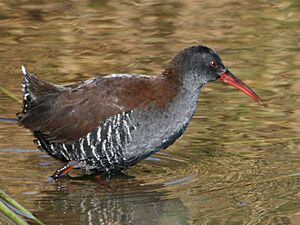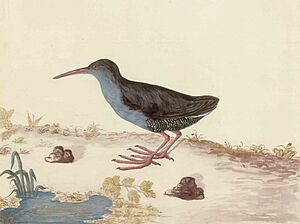African rail facts for kids
Quick facts for kids African rail |
|
|---|---|
 |
|
| Cedara Farm, Pietermaritzburg, KwaZulu-Natal, South Africa | |
| Conservation status | |
| Scientific classification | |
| Genus: |
Rallus
|
| Species: |
caerulescens
|
The African rail (Rallus caerulescens) is a small wetland bird. It belongs to the rail family. You can find this bird in eastern and southern Africa.
Contents
About the African Rail's Name

The African rail got its official name in 1789. A German scientist named Johann Friedrich Gmelin described it. He gave it the scientific name Rallus caerulescens.
The word caerulescens comes from Latin. It means "bluish." This name fits the bird's blue-grey feathers. This bird is the only type of its species. It does not have any subspecies.
What Does the African Rail Look Like?
African rails are about 27 to 28 centimeters (10.5 to 11 inches) long. Their upper bodies are mostly brown. Their undersides are blue-grey. They have black and white stripes on their sides and under their tails.
Both male and female birds look similar. However, the female is a bit smaller. This rail is special because it is the only Rallus species with a plain back. Their bodies are flat on the sides. This helps them move easily through tall reeds.
They have long toes and a short tail. Their bill is long, thin, and dull red. Their legs are also red. Young African rails look like the adults. But their blue-grey parts are more of a buff color.
African Rail Sounds
These birds are quite noisy. They make a trilled whistling sound. It sounds like treee-tee-tee-tee-tee.
Where Do African Rails Live?
African rails live in marshes and areas with lots of reeds. Their homes stretch across eastern and southern Africa. You can find them from Ethiopia all the way to South Africa.
Many of these birds stay in one place all year. But some will move to different wetlands. They do this when the water levels change.
African Rail Behaviour
How African Rails Raise Their Young
African rails build their nests in dry spots within marsh plants. Both the male and female birds help build the nest. It is shaped like a cup.
A female African rail usually lays 2 to 6 eggs. The eggs are creamy-white with many spots. Both parents take turns sitting on the eggs. The eggs hatch after about 20 days. The baby chicks are black and covered in soft down feathers.
What African Rails Eat
These birds use their long bills to search for food. They poke around in mud or shallow water. They also pick up food they see. Their main diet includes insects, crabs, and other small animals that live in the water.


